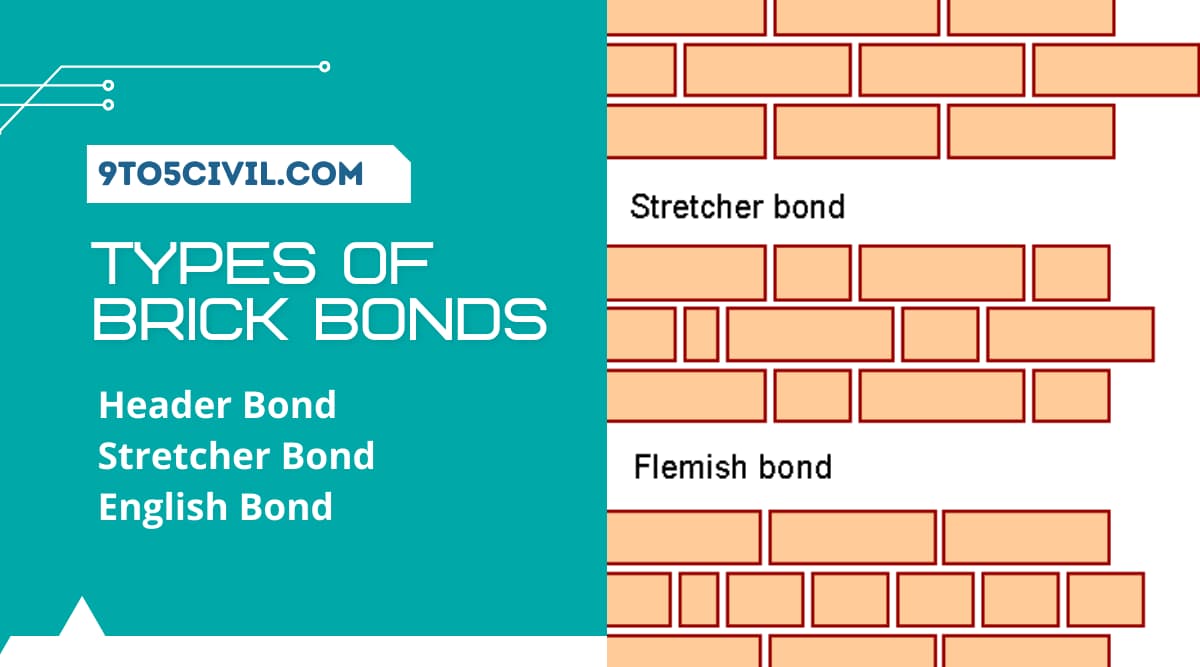Types of Brick Bond
Types of brick bonds in brick masonry The different type is provided depending on the style of placing bricks in the walls and the binding style. Brick masonry is developed by filling mortar in layers and joints using a brick bond. In which the bricks in the wall are laid side by side and in layers.
Brick masonry is one of the oldest and most useful building materials used in the world. Brick masonry is widely used in building elements as a durable form of construction.
The building masonry is constructed by placing several bricks in a proper sequence on the mortar. Through which the resistance of the imposed load can be safely transferred.
Bonding is important in brick masonry. The method of arranging bricks in mortar in masonry construction is known as brick bonding.
What Is Types of Brick Bond?
In brick masonry bricks are laid in a pattern. Thus, the arrangement of bricks in the construction of brick masonry is called a brick bond. In brick masonry, various brick patterns are made in their own appearance, installation difficulties, and structural structure in the case of walls.
Brick masonry work uses bricks of the same size in most all bonds. Or at least a matching size brick is used. In brick masonry, this is done using the appropriate pattern of brick on the bed of mortar. Evidence of various patterns of brick masonry can be found in all the ancient and historical buildings.
The strength of brick masonry depends on the type of brick bond and the type of material. Brick Bond plays an important role in providing strength, stability, and durability of brick masonry.
Type of Brick Bond
- Header Bond
- Stretcher Bond
- English Bond
- English Garden Wall Bond
- Flemish Bond
- American Bond & Scottish Bond
- Raking Bond
1. Header Bond
The short square face of the brick in the header type of brick bond is 9cm x 9cm. Header bonds are known as heading bonds. In header bonds, all the bricks in each layer in masonry are placed as headers on the face of the walls.
This type of brick bond allows better alignment for curved walls. In the header bonds, the thickness of the brick becomes 18cm thick.
2. Stretcher Bond
Stretcher bond in brick is the simplest brick pattern. But stretcher bonds cannot effectively bond in 18-inch brick masonry. This type of stretcher bond is used especially in partition walls.
Stretcher bonds are commonly referred to as running bonds. In this type of stretcher bond, only the length of the brick is laid. This type of bricklayer pattern overlaps the bricks below and above.
Brick masonry using stretcher bonds does not have enough stability to stand alone in case of long span and height. Thus, a supporting structure like brick masonry or column is needed to support the brick masonry made in the stretcher bond.
Stretcher bonds are commonly used as an exterior face in reinforced concrete framed structures of high-rise buildings. This type of stretcher bond is also used as the outer face of boundary walls, gardens.
3. English Bond
The English bond of brick masonry is made using a layer of the stretcher and a layer of the header above it. Thus, this type of brick pattern has a repetition of stretcher and header.
To break the alignment of verticle joints, brick masonry is constructed using the first header and lastly the Queen Closer. Quinn Close is a form of a brick cut in two lengths. It is used in the corners of brick walls.
4. English Garden Wall Bond
The pattern of bricks in the English garden wall is similar to the English bond. In this type of brick bond, the heading course is inserted only after every 3 layers. And stretchers brick pattern is used in 3 layers. In short, this type of brick bond brick masonry uses one course of headers and three courses of the stretcher.
The vertical joint is arranged in the header coarse using the queen closer.
5. Flemish Bond
Flemish bonds are also known as Dutch bonds. The flemish bond brick pattern is made by placing headers and stretchers in a single layer course.
Flemish bond brick pattern, the header rests in the middle of the stretcher in the course below. In Flemish Bond brick masonry, the course of each layer starts with a header in the corner.
Flemish bond thickness is usually at least one full brick. Flemish bonds are difficult to use as brick masonry. Flemish bond requires more skill in arranging bricks. All vertical mortar joints need to be aligned for the best effects of the Flemish bond pattern.
Flemish bonds can be divided into two types:
5.1. Single Flemish Bond
In single Flemish bond, English bond and Flemish bond are used in brick masonry. This brick pattern has a Flemish bond as the face of the wall. And English bond support in the baking course.
A single flemish bond cannot be used in a brick masonry less than one or half a brick in thickness. Single Flemish Bond is used in brickwork to ensure full strength and to give an attractive appearance of Flemish Bond.
5.2. Double Flemish Bond
In double Flemish bond, each course represents the same brick pattern in both front and back elevation in brick masonry. In each course, the headers and stretchers are arranged on a mortar. This type of brick masonry bond is used keeping in mind the economy and appearance. The bond in this type of brick bond is usually weaker than the English bond.
6. American Bond & Scottish Bond
In the Scottish Bond, the stretchers course is used 5 times consequentially under the header course. While in American Bond the header coarse is followed by 7 times consequently brick masonry in the coarse.
7.Raking Bond
The arrangement of bricks is laid in brick masonry at any angle except zero or ninety degrees. This brick pattern helps to increase the stability of the thick walls formed in the English bond. This brick bond is arranged at certain intervals along with the wall height of the brick masonry.
The brick masonry of the racking bond is represented in three brick patterns.
7.1. Herring-Bone Bond
This type of brick bond is suitable for very thick walls in brick masonry. In this type of bond, the brick pattern is the laying of bricks in a 45-degree course in two directions from the center. This type of brick bond is mostly used for brick paving.
7.2. Diagonal Bond
This type of brick bond is suitable for walls of two to four brick thicknesses. Diagonal bonds with wall height are usually represented every fifth or seven-course. This types of bond is arranged with a stretcher face.
7.3. Zig Zag Brick Bond
In the case of brick masonry in a zig-zag bond, the bricks are laid in a zig-zag pattern. This type of brick bond is especially used in brick flooring.
Different Types of Brick Patterns
| Sr. No | Brick Pattern | Name of Brick Pattern |
| 1 |  |
Header Bond |
| 2 |  |
Stretcher Bond |
| 3 | 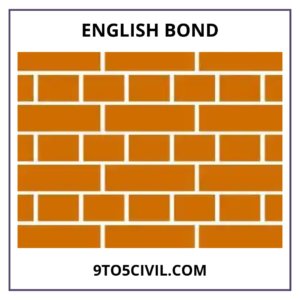 |
English Bond |
| 4 | 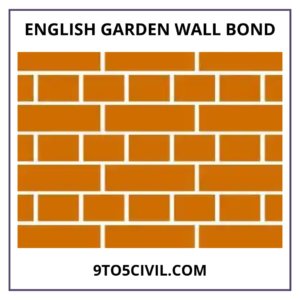 |
English Garden Wall Bond |
| 5 | 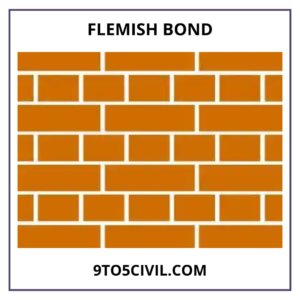 |
Flemish Bond |
| 6 | 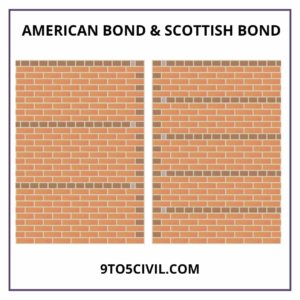 |
American Bond & Scottish Bond |
| 7 |  |
Herring-Bone Bond |
| 8 | 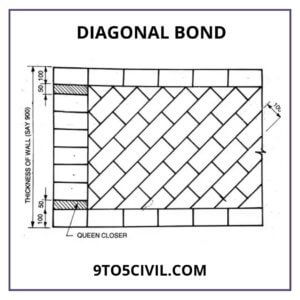 |
Diagonal Bond |
| 9 | 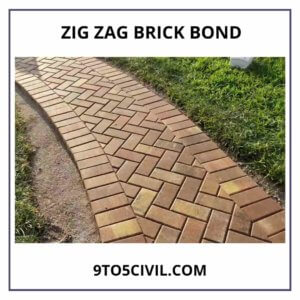 |
Zig Zag Brick Bond |
Suggested Read
English Bond. Flemish bond. Mortar is a spreadable mixture of water, sand, lime and cement used to permanently bond bricks together to create a strong foundation. When mortar dries, it is similar to brick in strength and structure and can withstand precipitation, sunlight, high temperatures and heat, including fireplace flames. When a contractor fails to abide by any of the conditions of the contract, the surety and contractor are both held liable. The three main types of construction bonds are bid, performance, and payment. English Bond. Excluding running bond construction, the most popular and widely used bond pattern with concrete masonry units is stack bond. From this it can be seen that properly reinforced stack bond masonry can be designed to be as strong as running bond construction. This bond is the strongest among all other bonds. This bond consists of alternate courses of headers and stretchers as shown in figure-1. As shown in the figure above, the vertical joints come over each other. This is also followed by the vertical joints of the stretcher course. Broken Bond. A common bond, also referred to as the American bond, has a course of headers inserted every five or six courses. A header is always centered on a stretcher and the joints of each course of headers always align. English bond in brick masonry has one course of stretcher only and a course of header above it, i.e. it has two alternating courses of stretchers and headers. Headers are laid centered on the stretchers in course below and each alternate row is vertically aligned. To break the vertical joints in the successive courses queen closers are placed in alternate courses next to the queen header. Bats are essentially required for the walls having their thickness equal to odd numbers of half bricks. Flemish bond gives better appearance than english bond. There is however a lot of relevant experience from brickwork manhole construction. … Less well known is the bond known as Water or Manhole Bond, which is a Collar Jointed construction where one leaf starts with a course half the normal height. This is formed by laying headers and stretchers alternately in each course. The headers of each course are centered on the stretchers of the course below. This bond is strong and often used for walls that are two bricks thick. A flemish bond is a brick construction pattern that consists of alternate stretchers and headers for each course. The main purpose of using a single Flemish bond is to provide a greater aesthetic appearance on the front surface with the required strength in the brickwork with an English bond. Double Flemish Bond has the same appearance both in the front and back elevations, i.e. each course consists of an alternate header and stretcher. This is considered to be the strongest bond. Hence it is a commonly used bond for the walls of all thicknesses. To break the continuity of vertical joints a brick is cut lengthwise into two halves and used in the beginning and end of a wall after the first header. This is called queen closer. In Double Flemish Bond, each course presents the same appearance both in the front and back elevations. Every course consists of headers and stretchers laid alternately. This type of bond is best suited from considerations of economy and appearance. Rat trap bond is a brick masonry method of wall construction, in which bricks are placed in vertical position instead of conventional horizontal position and thus creating a cavity (hollow space) within the wall. The pattern is called herringbone because it resembles the skeleton of a herring fish. … Tweed cloth is often woven with a herringbone pattern. Fatigue uniforms made from cotton in this weave were used by several militaries during and after World War II; in US use, they were often called HBTs. brickwork bond in which concealed courses of diagonally laid bricks are used to bond exposed brickwork to the wall structure. English and dutch bonds are the particular patterns of laying bricks for constructing a wall. the basic difference is – English Bond – a bond used in brickwork consisting of alternate courses of stretchers and headers. Dutch bond – is created by laying alternate headers and stretchers in a single course. A running bond pattern involves laying your square or rectangular pavers in a linear, side-by-side pattern, but staggering every other row — similar to the classic subway tile look. Here is what a running bond pattern looks like both in an indoor living room and a backyard patio with a pool. Stretcher bond also called a running bond, is created when bricks are laid with only their stretchers showing, overlapping midway with the courses of bricks below and above. Stretcher bond in the brick is the simplest repeating pattern. What Are the Five Types of Brick Bonding Methods? Stretcher Bonds Are Commonly Used in the Steel or Reinforced Concrete Framed Structures as the Outer Facing. These Are Also Used as the Outer Facing of Cavity Walls. Other Common Applications of Such Walls Are the Boundary Walls, Gardens Etc. There are five basic structural bonds commonly used today that create typical patterns. These are: Running bonds, common or American bond, Flemish bond, English bond, and block or stack bond.What Is the Strongest Brick Bond?
What Is the Weakest Brick Bond?
How Do You Bond Bricks Together?
What Are the Three Major Types of Construction Bonds?
Which Bond Is Best in Brick Masonry?
Is Stack Bond Strong?
Is Flemish Bond Strong?
What Is Broken Bond Brickwork?
What Is a Common Bond Brick?
What Is English Bond in Brick Work?
Which Bond Has Better in Appearance Than English Bond?
What Is Water Bond in Brickwork?
Types of Brick Bond
What Is Flemish Bond in Brickwork?
What Is the Difference Between English Bond and Flemish Bond?
Where Is Flemish Bond Used?
Why Are English Bonds Used?
What Is Double Flemish Bond in Brick Masonry?
What Is Rat Trap Bond in Brickwork?
Why Is It Called Herringbone Pattern?
What Is a Raking Bond?
What Is Dutch Bond?
What Is a Running Bond Pattern for Pavers?
What Is Stretcher Bond?
Where Is Stretcher Bond Used?
What Are the Five Types of Brick Bonding Methods?
 Skip to content
Skip to content
